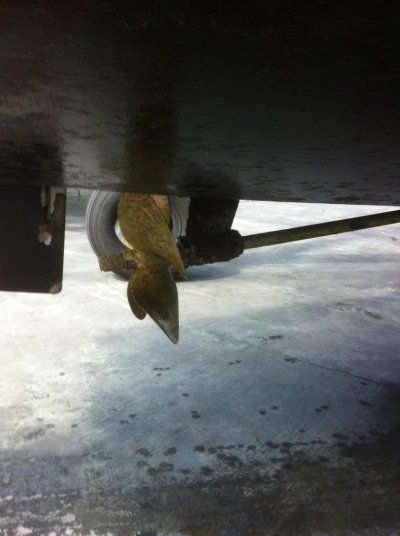ScottA
Member
- Joined
- Jan 20, 2010
- Messages
- 22
- Location
- Australia
- Vessel Name
- FIVE STAR
- Vessel Make
- 2012 Beneteau Antares Flybridge
Hi all,
Have just hauled out after 12 months, suprisingly not much growth on the bottom, except for some barnacles on the prop shaft strut(see pic) and in the bow thruster tunnel.
I have 3 areas zinc anodes, two small ones on the rudder(which were nearly gone) one on the end of the prop(30% gone) and one on the transom abt 3" dia and 2" thick this was virtually as new.
The guy who hauled the boat showed concern that the annode on the transom had not been eaten and said this was probally the cause for the barnicles on the stut and i should check the bond between the strut and the transom anode.
Also he said there was to much anode on the rudder and that is why i was loosing paint(see Pic), so he only put one back on, and put some more paint on the rudder
So I located two cables going from the strut to the transon anode(It was included in quite a sum of wires all going to the transom anode.
I also looked at the wiring diagram with the boat and relised that the rudder,engine and some components and engine exhaust are all bonded to this transom anode.
Any clues on this would be helpful
Regards Scott
Have just hauled out after 12 months, suprisingly not much growth on the bottom, except for some barnacles on the prop shaft strut(see pic) and in the bow thruster tunnel.
I have 3 areas zinc anodes, two small ones on the rudder(which were nearly gone) one on the end of the prop(30% gone) and one on the transom abt 3" dia and 2" thick this was virtually as new.
The guy who hauled the boat showed concern that the annode on the transom had not been eaten and said this was probally the cause for the barnicles on the stut and i should check the bond between the strut and the transom anode.
Also he said there was to much anode on the rudder and that is why i was loosing paint(see Pic), so he only put one back on, and put some more paint on the rudder
So I located two cables going from the strut to the transon anode(It was included in quite a sum of wires all going to the transom anode.
I also looked at the wiring diagram with the boat and relised that the rudder,engine and some components and engine exhaust are all bonded to this transom anode.
Any clues on this would be helpful
Regards Scott


